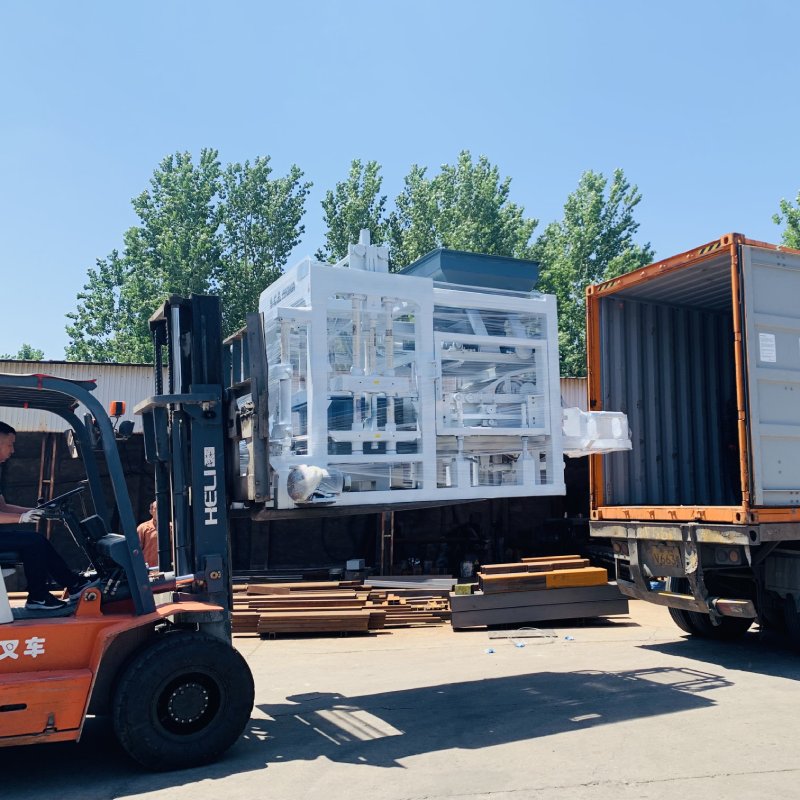
Image source Aiweiblockmachine
Transportation costs can significantly impact the overall expenses of construction projects. Block making machines offer a solution to reduce transportation costs by enabling on-site block production. This article explores the relationship between block making machines and the reduction of transportation costs in construction. It discusses the challenges associated with transporting precast blocks, the advantages of on-site block production, and the benefits of incorporating block making machines to optimize transportation logistics and save costs.
Challenges of Transporting Precast Blocks :
Transporting precast blocks from off-site manufacturing facilities to construction sites can be expensive and time-consuming. Factors such as long distances, traffic congestion, and logistical coordination add to transportation costs. Handling oversized or heavyweight blocks poses additional challenges and requires specialized equipment and transportation arrangements.
On-Site Block Production :
Block making machines enable on-site block production, eliminating the need for transportation of precast blocks. This approach brings the production process closer to the construction site, reducing the distance and associated costs of transporting blocks from external suppliers.
Just-in-Time Production :
On-site block production allows for just-in-time production, ensuring that blocks are manufactured precisely when and where they are needed. This eliminates the need for storing and managing large quantities of precast blocks, reducing inventory costs and the risk of material damage or deterioration.
Cost Savings :
Incorporating block making machines for on-site production can lead to significant cost savings. By eliminating or reducing transportation costs, construction projects can allocate resources more efficiently, resulting in overall budget optimization. The cost savings can be redirected to other project requirements, such as quality materials, skilled labor, or additional construction activities.
Flexibility in Material Sourcing :
Block making machines provide flexibility in material sourcing. Construction projects can utilize locally available materials, such as aggregates, cement, or additives, to produce blocks on-site. This reduces the dependence on external suppliers and minimizes transportation costs associated with procuring materials from distant locations.
Supply Chain Optimization :
Incorporating block making machines allows for the optimization of the construction supply chain. By producing blocks on-site, the project team has greater control over the production schedule, quality, and quantity of blocks required. This streamlines the supply chain, reduces lead times, and minimizes the risk of delays or disruptions caused by external suppliers.
Reduced Construction Delays :
Transportation delays of precast blocks can cause construction schedule disruptions. By adopting block making machines, construction projects can minimize or eliminate delays associated with external transportation factors. On-site production ensures a constant supply of blocks, allowing construction activities to progress smoothly and according to the planned timeline.
Enhanced Project Efficiency :
The reduction of transportation costs through block making machines enhances overall project efficiency. Construction teams can allocate resources more effectively, minimize downtime, and streamline construction activities. The availability of blocks on-site ensures a continuous workflow, reducing idle time and improving project productivity.
Environmental Sustainability :
Reducing transportation distances by adopting block making machines aligns with environmental sustainability goals. By minimizing the carbon footprint associated with transporting precast blocks, construction projects contribute to lower greenhouse gas emissions. This promotes a more sustainable construction industry and aligns with green building practices.
Case Studies and Success Stories :
Examining case studies and success stories of projects that have utilized block making machines for reducing transportation costs can provide practical insights and inspiration. Real-life examples of projects that have optimized supply chains, achieved cost savings, and improved project efficiency through on-site block production can serve as benchmarks for future construction projects.
Future Trends and Innovations :
As technology continues to advance, block making machines are likely to witness further innovations that reduce transportation costs. This may include advancements in block manufacturing processes, improved machine mobility, or the integration of automation and robotics for on-site production.
Conclusion :
Block making machines offer a solution to reduce transportation costs in construction by enabling on-site block production. This approach eliminates the need for transporting precast blocks, optimizes the supply chain, and enhances project efficiency. The cost savings achieved through reduced transportation expenses can be redirected to other project requirements, contributing to budget optimization and overall project success. By adopting block making machines, construction projects can improve their environmental sustainability, minimize construction delays, and achieve greater flexibility in material sourcing. The utilization of block making machines marks a significant advancement in construction logistics, promoting a more efficient and cost-effective construction industry.
Factors to consider when buying a hopper dryer
Here are the key things you should know when buying hopper dryers:
- Hopper dryer capacity: This refers to the volume of the plastic material that the dryer can handle at a time. The capacity that you choose should match your production needs. Whether it is a 25kg hopper dryer or 1000kg, you should specify.
- Temperature range: This is the maximum temperature that you can choose on the hopper dryer. Some dryers have low range while others have a high-temperature range.
- Speed: How long will it take for the dryer to completely dry the plastic material? Check out the estimated drying time of the equipment.
- Design and style: You should choose a hopper dryer that has sleek design and modern style. For example, its control panel should allow you to perform an array of functions.
- Performance and efficiency: The hopper dryer should be able to deliver excellent performance when it comes to drying plastic material. The equipment should also be energy-efficient such that you won’t have to pay high energy bills.
Choose reliable hopper dryer manufacturer in China
Where you buy a hopper dryer will always matter. If you are planning to buy a hopper dryer in China, ensure that it is from a reputable source. This is where comes in. We are a known manufacturer of quality hopper dryers in China.
Other than the quality equipment, we also have excellent customer support. All you need is to analyze your production and we will help you get the right hopper dryer.
